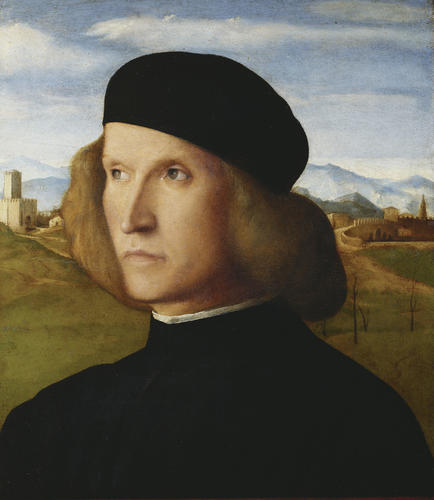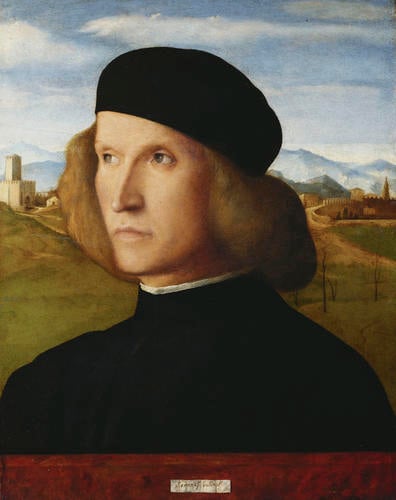-
1 of 253523 objects
Portrait of a Young Man c. 1505
Oil on panel | 43.8 x 35.2 cm (support, canvas/panel/stretcher external) | RCIN 405761

Giovanni Bellini (c. 1430-1516)
Portrait of a Young Man c. 1505


-
This is Bellini’s last surviving portrait and the only one to include a landscape background. It is signed on a fictive label, seemingly attached to the parapet. The subject wears the black biretta and robe of a Venetian cittadino, the social group below the patrician class. It has been suggested that he may be the Venetian writer and humanist Pietro Bembo (1470-1547).
The painting follows a characteristic Bellini format, with a head and shoulders seen in three-quarter view behind a parapet. Bellini’s portraits are inspired by Netherlandish examples and by the work of the most Netherlandish of his Italian contemporaries, Antonella da Messina. These influences affected the format and persuaded Bellini increasingly to abandon an egg tempera technique in favour of the medium of oil paint, seen here. Portraits by Hans Memling, which are mentioned in Venetian inventories of the period, often contain landscape backgrounds. In the portraits from this later period of his life, such as ‘Doge Leonardo Loredan’ of c.1501 (National Gallery, London) Bellini signed his name on a cartellino or fictive label, like the one apparently attached to the parapet here. The cursive lower case lettering of the signature here is rare, but other late paintings also have it.
In the 1940s it was proposed that the portrait depicted the writer and humanist Pietro Bembo. Bembo was born in Venice but lived at the courts of Urbino, Ferrara and Rome, where he became Papal Secretary in 1513 and Cardinal in 1538. His best-known work was ‘Gli Asolani’ of 1505, a dialogue on love set at the court of Caterina Cornaro at Asolo. An eminent philologist, he wrote on the Latin and Italian languages and amassed a large collection of paintings and antiquities. According to Vasari, Giovanni Bellini painted a portrait of Bembo’s mistress (now lost) and received two sonnets praising its beauty in return. Bellini’s later biographer Carlo Ridolfi lists a portrait of Pietro Bembo by Bellini, but there is no mention of it elsewhere.
The date of this picture (c.1505) means that Pietro Bembo would here be aged about 35, which is plausible. Unfortunately identification must depend upon a handful of portraits recording Bembo’s features in his sixties: a medal of c.1532 by Valerio Belli (the only one to show him beardless); one of the later 1530s by the medallist ‘TP’; the famous Titian portrait of c. 1539 (National Gallery of Art, Washington); and another medal of c.1547, attributed to Danese Cattaneo. Comparison of likenesses is notoriously subjective: the Bellini portrait does have Bembo’s aquiline nose, but the distinctive high set of the eyes and sloping angle of the brow seem different.
After 1500 Bellini gradually developed a broader, simplified style, losing the need to specify details. Here sitter and landscape are painted as a unity, both lit by a soft golden light, outlines blurred. Infra-red reflectography reveals very little underdrawing, which is typical of Bellini’s late technique. The modelling of the man’s face is extremely subtle and in places insubstantial so that the shadow where his lips press together is created by one underdrawn line, with no carbon or brown in the layers of paint. The horizon line across the top of the bridge was marked into the ground, over which there are few layers of paint. There is a lack of detail in the middle ground, while the distant buildings and mountains are built up in simple planes.
The marble parapet here is a trompe l’oeil, apparently as real as the frame, onto which a sharply creased cartellino seems to have been casually stuck; behind this barrier Bembo (or some as yet unidentified Venetian citizen) inhabits a separate, softer, more luminous and tranquil world.Provenance
Acquired in 1762 by George III from Joseph Smith, British Consul in Venice (Italian List no 285)
-
Creator(s)
Acquirer(s)
-
Medium and techniques
Oil on panel
Measurements
43.8 x 35.2 cm (support, canvas/panel/stretcher external)
60.6 x 50.1 x 5.0 cm (frame, external)
Category
Object type(s)
Other number(s)
Alternative title(s)
Self-portrait, previously identified as
A man in a black Birretta, previously entitled
Pietro Bembo, previously identified as